HubSpot is one of the most powerful and popular CRM tools on the market, offering extensive customer-tracking data and an onslaught of both marketing and sales features to help you sell more, faster.
One of those features is a native lead scoring tool. While it’s a good start into lead scoring, you need to know the best practices for how to use it. (And ultimately, we recommend using HubSpot’s data with our own lead scoring tool instead, but we’ll get to that).
HubSpot data can be powerful, and scoring leads is only one way to use it. But what if you could utilize your HubSpot data to surface revenue opportunities across the whole customer journey?
Knowing how to implement HubSpot lead scoring is crucial, so in this post, we’re going to first discuss the four essential best practices that you need to know.
Then, we’re going to see how you can leverage your HubSpot data to strengthen your sales pipeline and inform your team when the time is right to reach out and close a deal, upsell, or even prevent a customer from churning.
The 4 HubSpot Lead Scoring Best Practices You Need to Know
If you want to use the HubSpot lead scoring tool that’s native to the system with professional and enterprise-level plans, there are a few crucial best practices that you’ll want to know first.
Let’s take a look at each one up close so you can get the most accurate results.
1. Leverage all relevant data and activities
HubSpot has plenty of data available to you, and it only makes sense to take full advantage of that.
Think about all the information that you have available by using HubSpot as your CRM, especially with third-party integrations attached. You know what sources of traffic brought customers to you, when they last responded to your email, what deals and packages they’re interested in, and so much about their demographics.
HubSpot’s app ecosystem can provide an abundance of information about who the user is, how they’re interacting with you, and what they’re interested in. Use all of the data that you can to determine which leads are most high-value, adding the relevant attributes and activities to the lead scoring tool.
2. Create individual scoring fields for both fit & engagement
Strong lead scoring software takes two different information fields into account: Fit and engagement.
Fit scoring automatically takes multiple data points into consideration, such as what industry the client belongs to, how big their company is, and other crucial qualities that will be directly relevant to whether or not they’re a target client.
Potential available spend, for example, would matter to a marketing agency, while a bookkeeping firm would likely care about how many employees would need to be on the employer of record payroll.
Engagement is also important, however, and it takes a look at how leads are interacting with your brand and how often. Someone who responds to emails promptly and has high open rates, for example, will have a higher likelihood of purchasing from you than someone who converted on a lead magnet but hasn’t opened any other messages.
Both matter. And if you’re on HubSpot’s enterprise plan, you can actually create individual lead scoring fields for both separately, as this plan (and this plan only) allows you to create up to 25 different fields. Take full advantage of that so that you can get more clear and accurate results.
3. Space out activity evaluations
All activity is not created equal in lead scoring; people who opened two emails are not as engaged as those who opened five, or those who opened an email aren’t nearly as engaged as those who actually responded to one.
It’s important to take this into consideration with your HubSpot lead scoring model because it won’t do this automatically.
You need to space out your activity evaluations so that “opened emails” or “viewed page on-site” are not flat metrics; instead, “opened 1-3” emails should get points, but fewer points than users who opened more emails and/or responded to some.
HubSpot is able to track most of this data on its own, and any third-party integrations can cover the rest; make sure that your lead scoring system is able to take the differences in activity into account.
4. Ensure you’re decreasing score for certain actions
HubSpot lead scoring allows you to not only add points when ranking leads for positive attributes but also to dock leads points for certain negative attributes.
You absolutely want to set up negative attributes that will decrease scores when certain actions are taken or qualities are met.
Every business owner or salesperson can spot certain red flags in potential clients that let them know that these leads are less likely to convert.
It may be obvious, like that they aren’t opening emails or they only signed up for the lowest-value free trial. It could even be that they belong to a certain industry, or answered a qualifying question a certain way.
A real estate agent, for example, might list “not qualified” as a negative; any leads coming to them in this market without preapproval from a lender aren’t serious yet.
It’s not a reason to count them out–they could want guidance about what lender to work with–but it means they won’t be ready to move quickly like other buyers.
Think about what actions and qualities make leads less likely to convert, or likely to fall into a lower-value audience segment, and test those criteria as negative attributes.
Why You Should Use Breadcrumbs & HubSpot For Lead Scoring
HubSpot has a lead scoring tool that’s available for both the professional and enterprise-level plans (the lowest cost of which starts at $450 a month).
It’s a decent tool, but we firmly believe that HubSpot users are much better off syncing HubSpot with Breadcrumbs so that we can leverage their extraordinary customer data into our specialized and advanced scoring tool that will allow you to uncover revenue opportunities throughout the customer journey.
Here’s why:
1. You can benefit from a Breadcrumbs and HubSpot partnership
We don’t just have an integration to sync your HubSpot data to Breadcrumbs… we have a formal partnership with HubSpot, as we’re a member of the Gold-level solutions partner program. We’re also certified by the HubSpot academy.
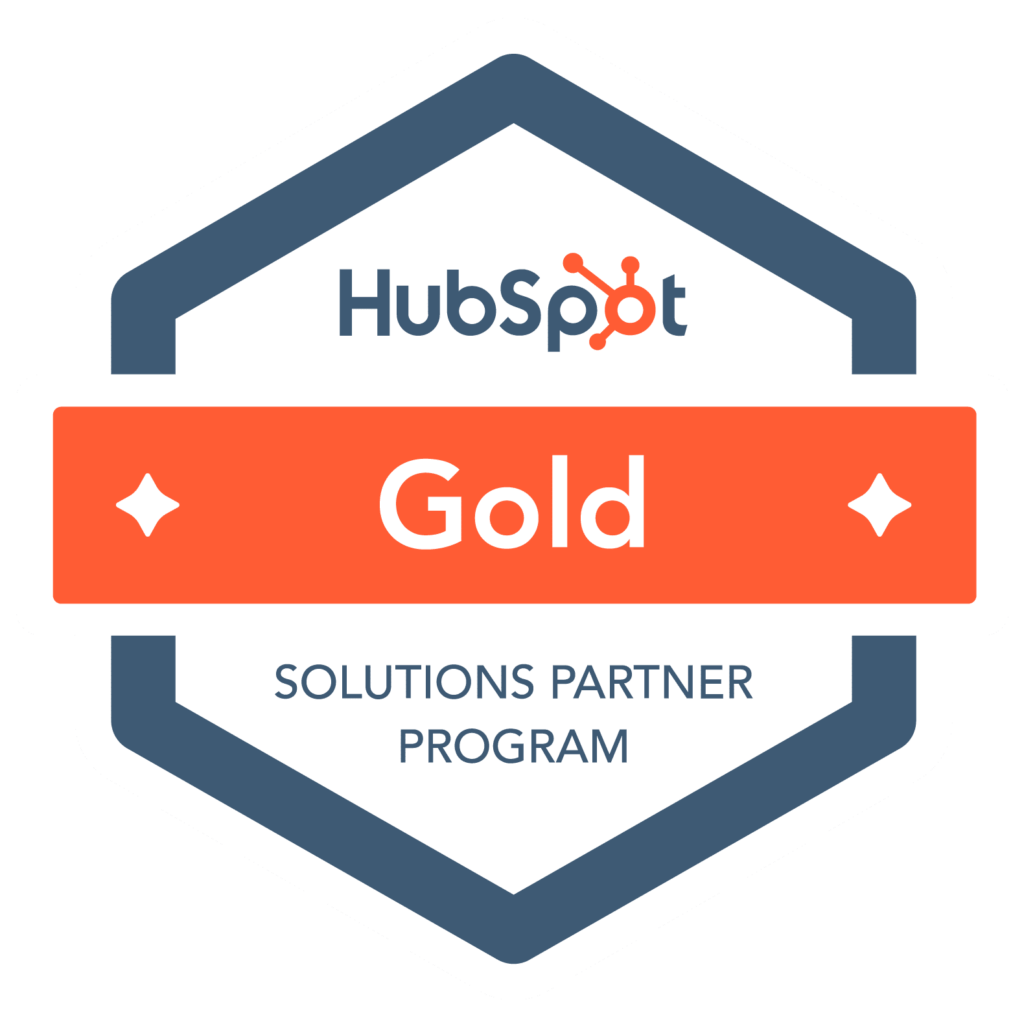
Here’s what this means:
- HubSpot has ensured that we’ll deliver outstanding customer experiences.
- We’ll help onboard you, including taking care of every part of the HubSpot set up, ranging from the basics to the complex. This includes:
- Integrating your email and data sources.
- Importing contacts.
- Integrating your website.
- Creating audience segments.
- Define deal stages.
- Create lead ads.
- Invite your team with assigned roles and access.
- We’ll streamline the data migration process, making it effective and highly secure.
- Get your account optimized to provide Breadcrumbs with high-quality data for lead scoring purposes, improving your lead scoring models overall.
- We can help with troubleshooting, enablement, and even just general support; whatever you need, we’re here.
You can take advantage of the benefits of HubSpot (which has outstanding tools, especially in their Sales and Marketing Hubs) while still getting actionable benefits from Breadcrumbs’ advanced lead scoring technology.
Which brings us to our next point…
2. What we do is so much more than just scoring leads
While HubSpot’s lead scoring tool focuses on exactly that–lead scoring–Breadcrumbs surfaces revenue opportunities across the whole customer journey.
Don’t get me wrong: lead scoring is still at the core of everything we do at Breadcrumbs, but we believe that our tool can do so much more than just scoring leads.
We call it Contact Scoring as it encompasses all the steps of the customer journey, not only leads.
Breadcrumbs’ powerful algorithm works with you to:
- Uncover Upsell and Cross-Sell Opportunities. You can use a contact scoring system to find customers close to their service limits and redirect them to the sales team when the moment is right or recommend some alternate products that are a better fit for your clients’ goals and reduce churn at the same time.
- Direct Hot Qualified Leads to Sales at the right time. Typically, we associate ‘lead scoring’ with directing qualified leads to sales–and for good reason. Handling only the most qualified leads to your sales team results in a higher percentage of closed deals and less time wasted. You can do this by scoring leads based on how similar they are to your buyer persona.
- Prevent Customer Churn Before it Happens. With contact scoring, you can score contacts based on such factors as login activity, product usage, and if they’ve stopped interacting with your website (blog, etc.). These contacts can then be transferred over to your customer service teams so they can reach out directly and prevent customer churn.
-
Lead Scoring vs Lead Nurturing: 7 Differences to Maximize Your Sales Funnel
Read more: Lead Scoring vs Lead Nurturing: 7 Differences to Maximize Your Sales FunnelManaging leads effectively means prospects move through the funnel efficiently, resulting in more conversions and…
3. We offer dedicated dashboards & analytics meant for contact scoring
HubSpot’s primary focus is not lead scoring; it’s more like a cool bonus feature.
Meanwhile, here at Breadcrumbs, we live and breathe all things related to scoring leads and contacts. It’s everything that we do, so we have specialized and dedicated dashboards and analytics that focus exclusively on this singular purpose. This gives you more actionable data that your marketing and sales teams can use to their benefit, giving you the big picture with nothing omitted.
See what this looks like here:
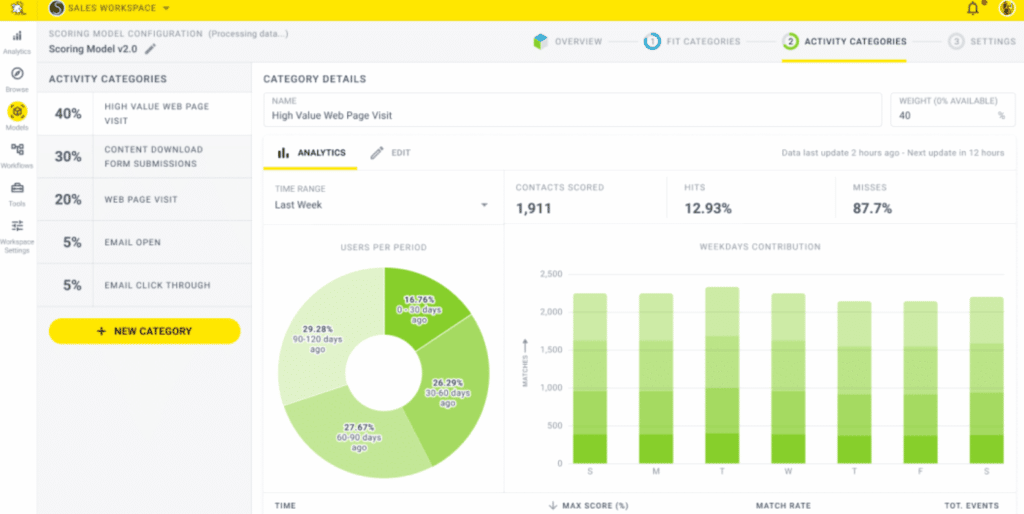
4. We offer both recency & frequency in activity scoring
We mentioned above that contacts who interacted with your business more were typically of higher value than those who interacted less frequently. This is typically true.
It’s also true that contacts who interacted with your business most recently are also more likely to convert on a great deal right now as opposed to someone who hasn’t engaged in two weeks.
Both matter… but on HubSpot, you can only choose to implement activity scoring with either frequency or recency, and not both.
That’s not the case with Breadcrumbs. Our complex contact scoring models account for both the number of times an activity was taken and how recently those activities were taken.
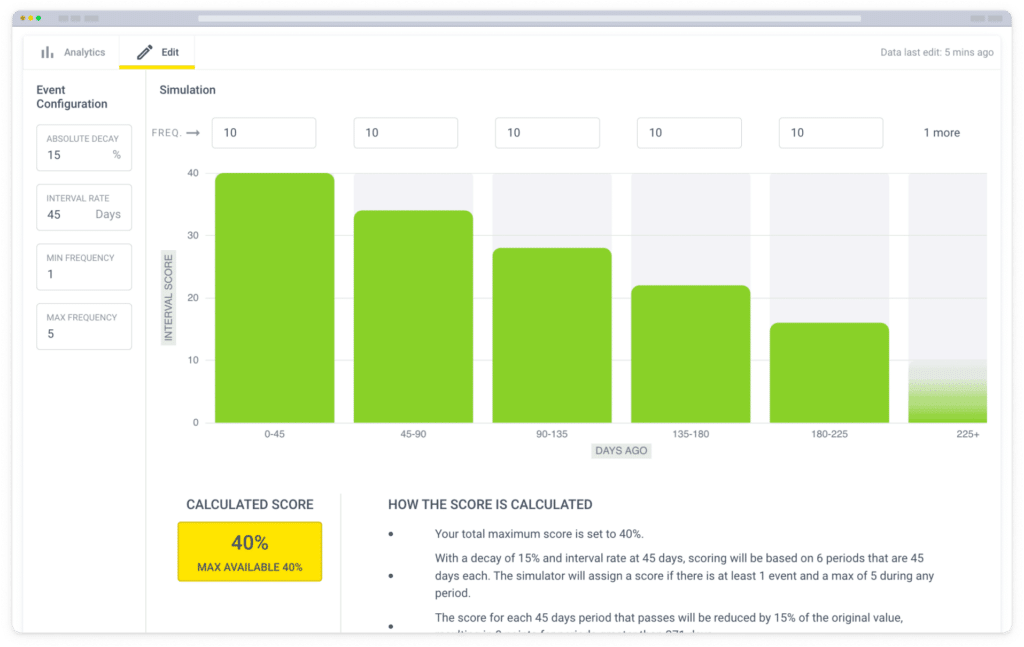
While it may seem like a small detail, this is actually extremely significant.
Recency tells you how recently a user took an action. Frequency tells you how often they took a specific action.
These both matter a great deal. A user who subscribed to your email list a week ago and has opened six emails is much more interested than someone who opened 20 emails over six months ago.
This information is invaluable for your sales team, helping them to decide who to prioritize so they can strike while the iron is hot.
For this reason, Breadcrumbs considers both recency and frequency in our models, using a built-in time decay feature so that all lead scores are up-to-date and accurate at all points in time.
5. We allow you to track fit & activity scores separately
We mentioned above that HubSpot really allows you a single field for both fit and engagement tracking unless you upgrade to their ultra-expensive enterprise-grade plan. And even if you do upgrade, you end up with two different lead scoring fields that may not merge as accurately as you might hope.
Breadcrumbs, on the other hand, offers co-dynamic scoring right off the bat. Track fit and activity engagement separately from each other while still being able to combine that data for incredibly accurate contact scoring assessments.
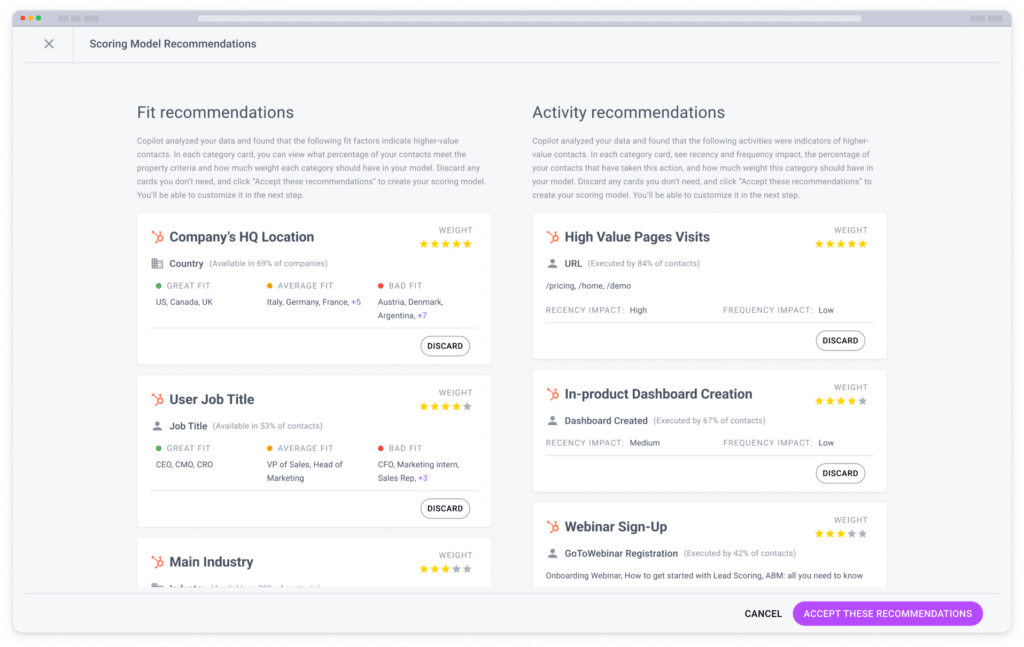
Create sophisticated contact scoring models with multiple interlocked dimensions that take fit, engagement, recency, and frequency into account all at once without becoming overwhelmed or inaccurate.
And if this sounds complicated, don’t worry; we’ll automatically recommend the best scoring model template based on your business type and the customer journey step you want to focus on, and let our system take it from there unless you want to make manual adjustments along the way.
6. We give you a historical view into your contact score trends
Markets evolve, products evolve, and consumer behaviors evolve. This means that businesses have to change over time and that the types of contacts you might be pursuing will shift, too.
Most tools like HubSpot’s will only show you lead scores as they exist right now with your current audience. At Breadcrumbs, however, we give you the option to look back at contact score trends that have impacted your business so you can see how things have changed over time.
This is a unique feature that most add-on bonus tools don’t have but that specialized platforms like Breadcrumbs believe are vital for that big-picture view of your business’s sales and acquisition pipeline.
We also offer split testing features so you can A/B test as many scoring models as you’d like.
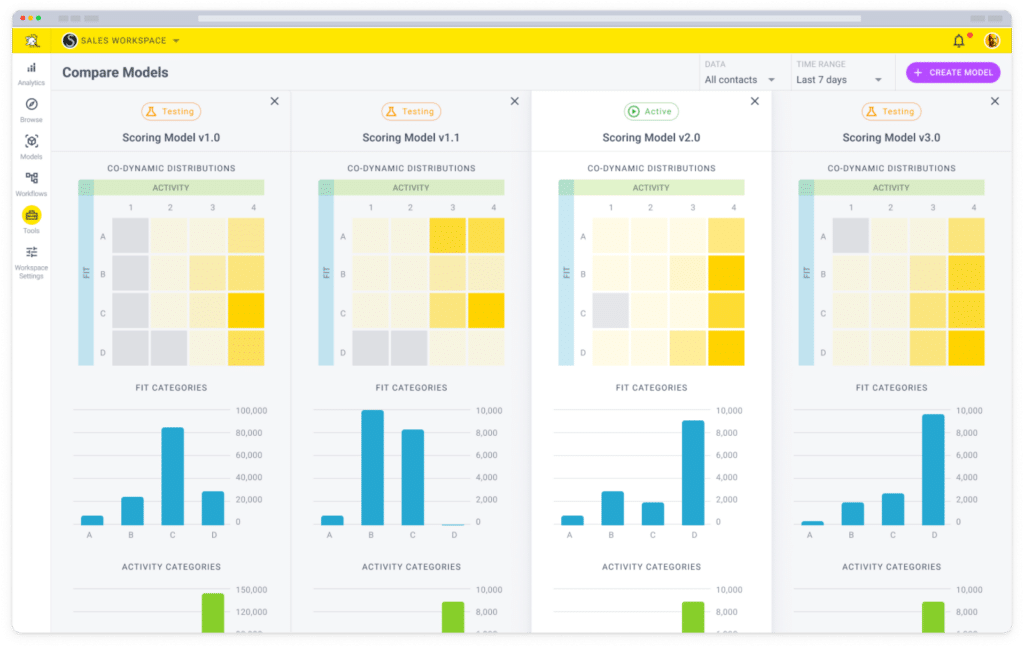
We actually recommend starting with a few data points and adding more in once your model stabilizes, making it easy to see how additional data points or alterations impact lead quality.
7. Utilize HubSpot workflows to improve lead scoring process
Breadrumbs uses HubSpot workflows to improve the lead scoring process to ensure that no stone is left unturned and that no lead is missed.
These workflows use automation to trigger actions when certain events occur. They can be complex, allowing you to automate multiple lead nurturing efforts ranging from generating new campaigns to alerting your sales team of high-intent leads.
Workflows are specifically a HubSpot feature, but they can be used to automate elements of lead nurturing or sales processes incorporating events and data in Breadcrumbs.
[Create list] “Free plan users” that collects a list of users who sign up for our free plan [Triggers workflow] List = “Free plan users” Email 1: “Welcome to your Breadcrumbs free account!” (includes introduction to Breadcrumbs + short tutorial on how to connect a data source) Step 1: Increment property value = Incomplete action (users didn’t connect their data source with Breadcrumbs) Email 2: “Forgot something?” (includes a reminder to connect a primary data source / schedule a call with lead scoring expert / invite user to upgrade to a paid plan and delegate scoring efforts to the Breadcrumbs team)
You can read about our favorite HubSpot lead scoring workflows in-depth, but here are a few worth noting:
- Nurturing leads with automated campaigns, like sending them a triggered email with a resource when they sign up for a lead magnet.
- Using automated list building and triggered workflows to keep leads up-to-date about relevant offers.
- Onboarding and nurturing campaigns for new freemium plan users.
Automated workflows are all about working smarter and not harder, making it easier for your sales team to do their jobs and stay on top of a hopefully ever-growing pipeline full of leads. Take advantage of them, and don’t be afraid to get creative.
What About HubSpot Alternatives?
This post is obviously Hubspot-centric: It’s a post about lead scoring tips with HubSpot.
But what about HubSpot alternatives?
There are other CRMs similar to HubSpot that also offer basic lead scoring tools, outstanding customer fit and activity data, workflow options, and (of course) integrate with Breadcrumbs.
The most direct lead scoring alternative to HubSpot is Salesforce. They offer many similar features (though they may be packaged up differently), including plenty of sales-focused functionality.
Salesforce only uses data that already exists in its platform for lead scoring, and its Einstein predictive scoring is only available for Enterprise accounts, but it’s an effective option that works similarly to HubSpot.
Ultimately, the best lead scoring alternative to HubSpot and Salesforce will be Breadcrumbs.
Breadcrumbs actually acts as a supplemental and standalone tool to these platforms; we integrate with both so their data can be leveraged in our system to create stronger and more accurate lead scoring models with the right data points.
Breadcrumbs offers more complex and robust contact scoring features with diverse functionality, giving you more accurate and actionable scores for everything from lead nurturing to cross-selling. Learn more here.
Final Thoughts
HubSpot lead scoring feature is a nice bonus for subscribers who are already using the tool, but it doesn’t offer the extensive capabilities truly needed to make it entirely reliable or accurate.
This approach focuses solely on scoring leads, leaving out key areas such as upselling, cross-selling, and churn detection.
Breadcrumbs can help you there.
You can sync up your HubSpot data to Breadcrumbs so you can get the best of both worlds, leveraging all that activity and fit data into a tool that will allow you to set up complex models for more accurate results for the whole of your customers’ journey.
Interested in learning more about how Breadcrumbs works? Schedule your free demo here.



